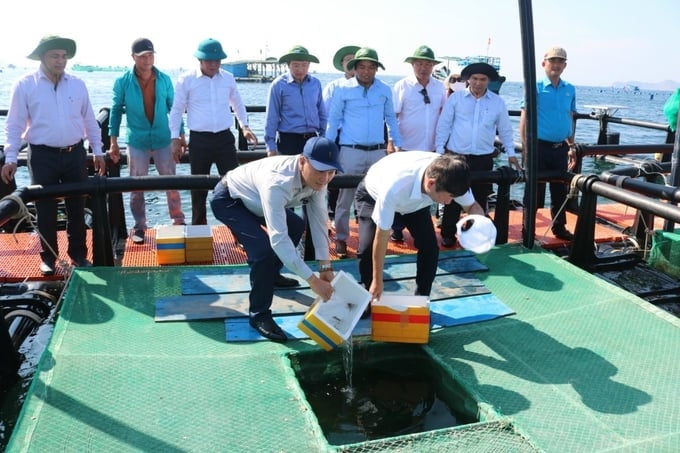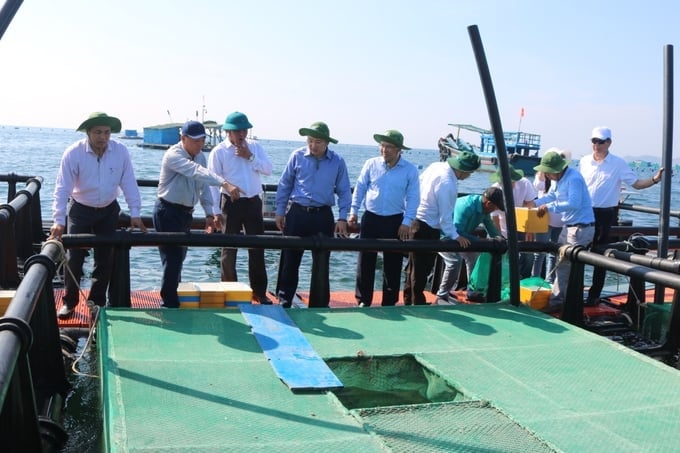November 25, 2025 | 23:48 GMT +7
November 25, 2025 | 23:48 GMT +7
Hotline: 0913.378.918
November 25, 2025 | 23:48 GMT +7
Hotline: 0913.378.918
As part of the High-Tech Mariculture Development Pilot Project in Khanh Hoa province, the Khanh Hoa Agricultural Extension Center established a pilot mariculture model in 2023, which utilizes round HDPE cages and a two-tiered lobster farming method. The objective of this model is to conduct experimental farming for subsequent replication. The initial stages of the model have garnered positive support from local mariculture households thanks to its introduction of a new and practical farming method.

High-Tech Aquaculture Model in Cam Ranh Bay, Khanh Hoa Province. Photo: KS.
According to Mr. Huynh Kim Khanh, Director of the Khanh Hoa Agricultural Extension Center, the center collaborated with various stakeholders in 2023 to select six households for the implementation of a pilot model which utilizes HDPE cages in a "stacked cage" configuration in the planned mariculture area within Cam Lap commune, Cam Ranh city. One of the selected households is engaged in lobster farming, whereas the remaining five are engaged in sea fish farming.
Mr. Phan Van Thanh's household operates two round HDPE cages, each with a diameter of 13 meters and a volume of 800 cubic meters, situated at a depth of 6 meters. Mr. Thanh introduced cobia into the cages on May 24, 2023. To date, the fish are exhibiting excellent growth, positive feeding habits, with a 100% survival rate. The current weight of the fish ranges between 3 to 3.5 kilograms per individual.

Two-tiered floating mariculture model, which helps save water surface area and supports the practices of local lobster farmers. Photo: KS.
Mr. Nguyen Minh Tho's household, on the other hand, farms green lobsters in 6 square HDPE cages with a total volume of 1,440 cubic meters. Mr. Tho suspends 2 tiers of iron cages, with a total suspended cage volume of 288 cubic meters. Mr. Tho introduced green lobster into the cages on May 24, 2023. To date, the lobsters are exhibiting excellent growth, with a 100% survival rate. The current weight of lobsters ranges between 170 and 200 grams per individual.
Mr. Nguyen Van Cu, Tran Van Trinh, and Tran Van My all farm fish in 2 round HDPE cages, each with a diameter of 13 meters, a volume of 800 cubic meters per cage, and farmed at a depth of 6 meters. To date, the fish in these cages are growing exceptionally well, with a 100% survival rate. Mr. Cu introduced fish seeds in August 2023, and the fish currently weigh an average of 2 to 3 kilograms each. Mr. Trinh and Mr. My introduced fish seeds in October, and the fish currently weigh an average of 1 kilogram each.
Mr. Vo Van Hoa's household initially farmed green lobsters in 6 HDPE square cages with a volume of 24 cubic meters per cage. However, Mr. Hoa later switched to sea fish farming, and presently, the fish are developing healthily, with an average weight of 0.5 kilograms per individual.
The two-tiered floating cage mariculture model, from its conception to design and construction processes, along with technical solutions, was proposed by Associate Professor Dr. Vo Van Nha, Deputy Director of the Research Institute for Aquaculture III. The proposal stemmed from practical experiences as well as the urgent needs in the South Central coastal mariculture regions.
According to Assoc. Prof. Dr. Vo Van Nha, the two-tiered lobster farming model not only saves water surface area but also supports the local traditional farming practices without affecting productivity and yield. Notably, areas with limited water surface area for mariculture, such as Phu Yen province, farmers face a shortage of water surface for cage placement. As a result, the two-tiered cage mariculture model can address this issue by conserving water surface area.
"Transitioning from traditional mariculture models to the two-tiered cage mariculture approach does not mean farmers have to discard their old cages. Instead, the existing cage system can be utilized to avoid incurring the cost of purchasing new cages," explained Assoc. Prof. Dr. Vo Van Nha.

Khanh Hoa province is currently implementing a pilot two-tiered floating mariculture model in Cam Ranh city. Photo: KS.
According to Assoc. Prof. Dr. Vo Van Nha, lobster farming in a two-tiered cage system requires the repositioning of the cage door (placed on the side) for convenient cage hygiene. Furthermore, the lower cage system typically bears the weight pressure of the upper cage, so the anchoring system must be different between the two cages.
"Lobster farming in a two-tiered cage system must be carried out at a depth of at least 8 meters. When lobsters are raised in a deep sea environment offshore, they can avoid pollution from the coastal areas. As a result, lobsters are less prone to diseases as they live in a cleaner environment," shared Assoc. Prof. Dr. Vo Van Nha.
Assoc. Prof. Dr. Vo Van Nha stated, "Mariculture in two-tiered cages will allow local farmers to reuse hundreds of thousands of existing sunken cages without the need for additional construction costs. Transitioning to a new farming model without discarding the old cage system is a cost-effective and suitable approach for the traditional lobster farming practices of the South Central Coast. However, in order to evaluate the effectiveness of this model, we must deploy pilot models and trials. New models are always challenging, but challenges are meant to be overcome. New models are often subject to a difficult starting phase, which is why local support is needed in the construction of the model. When the model's efficiency is confirmed, farmers will naturally adopt it without the need for promotion or encouragement. They will follow examples once they experience the benefits first-hand."
Translated by Nguyen Hai Long
/2025/11/24/3536-2-112800_176.jpg)
(VAN) Dong Nai now has tens of thousands of hectares of forests certified for sustainable management, and this area will continue to be expanded in the coming period.

(VAN) Vinh Ha hamlet (Dai Xuyen commune, Hanoi) is shifting away from small-scale farming as households adopt bioscurity into their breeder chicken models.

(VAN) Heavy rains make aquatic species more vulnerable to disease. Proactive water management and high-tech systems help farmers prevent outbreaks and protect yields.

(VAN) Greenhouses are shifting production mindsets in Binh Lu commune, enabling farmers to ‘weather the sun and rain’ and secure stable vegetable harvests throughout the year.

(VAN) Green transition is crucial for the Mekong Delta amid climate change and stricter standards, offering a path toward sustainability.

(VAN) Dong Thap promotes agricultural restructuring, forms large specialized farming zones, raises the value of agricultural products and develops toward ecological and high-tech directions.
/2025/11/22/4018-4-213342_747.jpg)
(VAN) The Mekong Delta Agricultural Experts Club has attracted 143 experts and researchers to participate in providing consultancy and contributing initiatives to the development of one million hectares of high-quality rice.